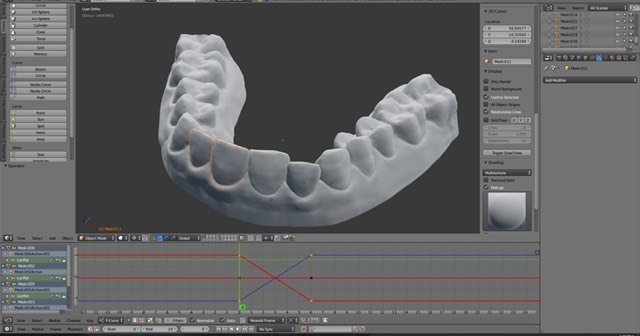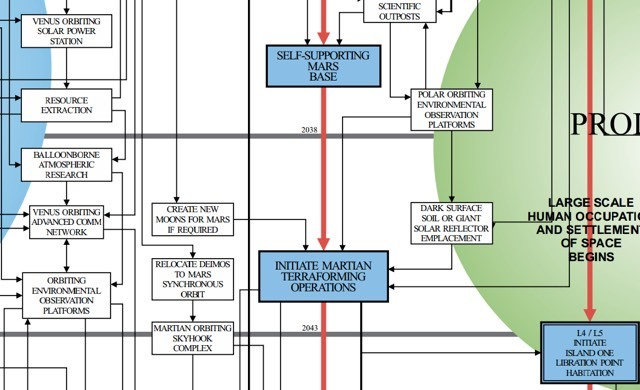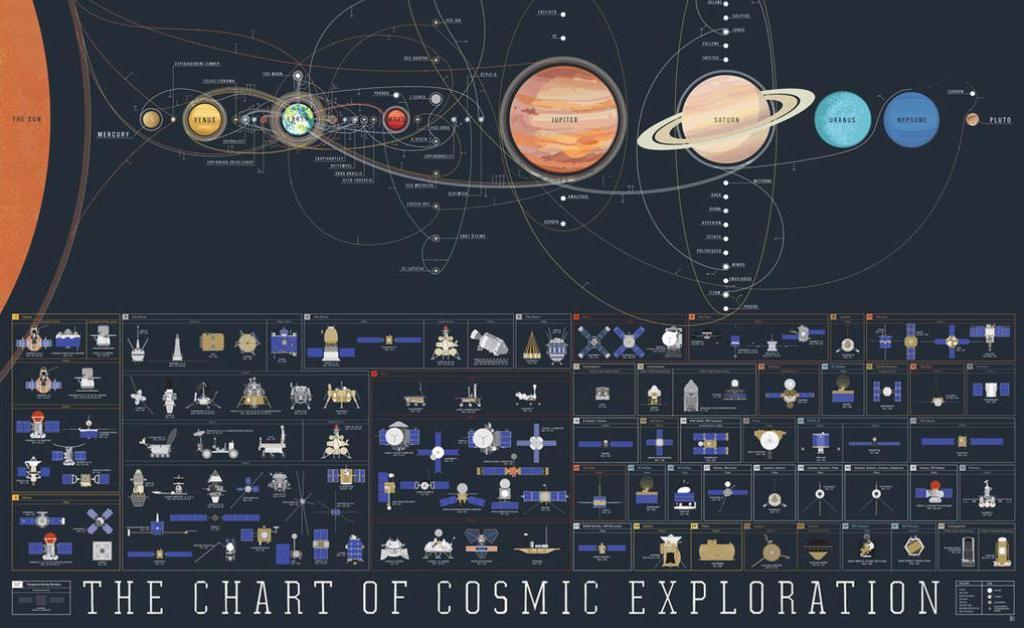Cool/Exciting/Interesting things (probably videos)
The chart of cosmic exploration
A new print from Pop Chart Lab “traces the trajectories of every orbiter, lander, rover, flyby, and impactor to ever slip the surly bonds of Earth’s orbit and successfully complete its mission – a truly astronomical array of over 100 exploratory instruments in all.”
DIY orthodontics

Amos Dudley wanted to improve his smile but didn’t want to pay thousands of dollars for Invisalign, so he 3D printed his own orthodontic aligners.
I took a mold of my teeth with some cheap alginate powder, Permastone, and a 3d printed impression tray, to get a better picture of what was really going on. Notice LI-r (right lateral incisor) projected outward, and CI-r (right central incisor) depressed inward and overlapping.
At the time of writing this, I’m an undergrad, which means that a) I’m broke, and b) I have access to expensive digital fabrication tools - definitely an unusual dichotomy. I was researching [name brand clear-aligner treatment], and I ran across a photo that caught my eye.
Scientists warn of dramatic climate shift much sooner than expected. A new paper by climate scientists, including ex-NASA scientist James Hansen, warns that our climate could dramatically change within decades, not centuries.
Virtually all climate scientists agree with Dr. Hansen and his co-authors that society is not moving fast enough to reduce emissions of greenhouse gases, posing grave risks. The basic claim of the paper is that by burning fossil fuels at a prodigious pace and pouring heat-trapping gases into the atmosphere, humanity is about to provoke an abrupt climate shift.
Slate’s Eric Holthaus has has more on the paper and its potential implications.
In addition to the risk of “several meters” of sea level rise this century, which Hansen calls the most important finding, the final version of Hansen’s paper gives new emphasis to the possibility that the ocean’s heat circulation system may be in the process of shutting down. The circulation shutdown would precede the rapid increase in global sea levels. If the shutdown happens, simultaneous cooling of the waters near Greenland and Antarctica and warming in the tropics and midlatitudes could spawn frequent strong storms on the order of Hurricane Sandy or worse.
Hansen also released a 15-minute video about the paper:
The latest video from Primitive Technology is about making a bow and set of arrows from scratch.
The unexpected vistas of the world’s coastlines

Beyond the Sea is a neat project by Andy Woodruff that visualizes what lies across the ocean from the world's coastlines. For instance, standing on the coast in North America looking straight out, you might see Brazil or the west coast of Africa, but also the east coast of Africa, India, and even Iran.
In the northern reaches of Newfoundland, near the town of St. Anthony, is the Fox Point Lighthouse. I’ve never been there, but I know it has one of the most impressive ocean views in the world. If you face perpendicular to the right bit of rocky coastline there and gaze straight across the ocean, your mind’s eye peering well beyond the horizon, you can see all the way to Australia.
What’s really across the ocean from you when you look straight out? It’s not always the place you think.
The next 100 years of humans in space

In 1989, a Rockwell engineer named Ron Jones published his Integrated Space Plan, a detailed outline of the next 100 years of human space travel, from continuing shuttle missions in the 1990s to the large scale habitation of Mars. The plan includes all sorts of futuristic and day-dreamy phrases like:
Create new moons for Mars if required
Humanity begins the transition from a terrestrial to a solar species
Humanity commands unlimited resources from the Moon and asteroids
Space drives global economy
Independent spacefaring human communities
Wired has a good look at how the plan came to be.
The graphic is divided into nine columns that show, in chronological order, the path toward human exploration of deep space. The center row of boxes, the “critical path,” outlines the major milestones Jones decided were attainable within the next century of space travel; the boxes to the left and right of the critical path are support elements that must be realized before anything on the critical path can happen. The Integrated Space Plan can be read top to bottom and left to right. The big circles intersecting the boxes are the the plan’s overarching long-range goals, which include things like Humanity begins the transition from a terrestrial to a solar species and Human expansion into the cosmos. In many ways, it’s a graphical to-do list.
The Panama Papers (It has a nice ring to it)
A huge cache of data has leaked from a Panama-based tax firm that shows how some of the world’s politicians and the rich hide their money in offshore tax havens. The video above, from the Guardian, is a quick 1:30 introduction on how these offshore havens work.
The documents show the myriad ways in which the rich can exploit secretive offshore tax regimes. Twelve national leaders are among 143 politicians, their families and close associates from around the world known to have been using offshore tax havens.
A $2bn trail leads all the way to Vladimir Putin. The Russian president’s best friend – a cellist called Sergei Roldugin – is at the centre of a scheme in which money from Russian state banks is hidden offshore. Some of it ends up in a ski resort where in 2013 Putin’s daughter Katerina got married.
Among national leaders with offshore wealth are Nawaz Sharif, Pakistan’s prime minister; Ayad Allawi, ex-interim prime minister and former vice-president of Iraq; Petro Poroshenko, president of Ukraine; Alaa Mubarak, son of Egypt’s former president; and the prime minister of Iceland, Sigmundur Davíð Gunnlaugsson.
Here is an important bit:
Are all people who use offshore structures crooks?
No. Using offshore structures is entirely legal. There are many legitimate reasons for doing so. Business people in countries such as Russia and Ukraine typically put their assets offshore to defend them from “raids” by criminals, and to get around hard currency restrictions. Others use offshore for reasons of inheritance and estate planning.
Are some people who use offshore structures crooks?
Yes. In a speech last year in Singapore, David Cameron said “the corrupt, criminals and money launderers” take advantage of anonymous company structures. The government is trying to do something about this. It wants to set up a central register that will reveal the beneficial owners of offshore companies. From June, UK companies will have to reveal their “significant” owners for the first time.



